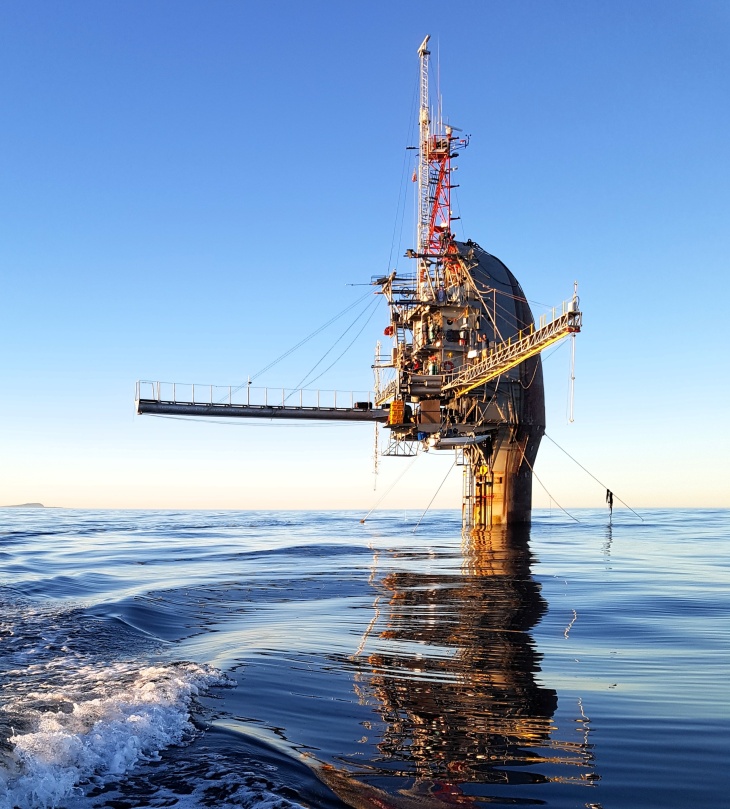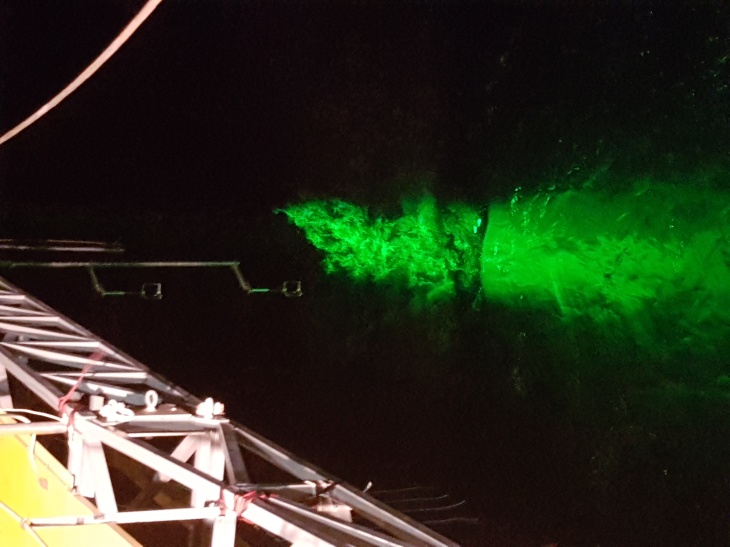How the wind shapes the waves
An international research team led by the Helmholtz-Zentrum Hereon has, for the first time, succeeded in visualizing and quantifying the complex airflow dynamics directly above the ocean surface in high resolution. Using an innovative laser measurement system, previously unknown and highly complex mechanisms of energy exchange between wind and waves have been deciphered — a significant step forward for climate research, weather models, and ocean dynamics. The research findings have been published in Nature Communications.
Measurements in the Pacific

The FLIP (FLoating Instrument Platform) research platform in the Pacific Ocean. Photo: Marc Buckley
The international team, led by Dr. Marc Buckley from the Hereon Institute of Coastal Ocean Dynamics, has achieved a breakthrough in high-resolution imaging of the ocean surface. Using a specially developed laser measurement system aboard the research platform FLIP (Floating Instrument Platform) in the Pacific Ocean, they were able to capture high-resolution images of airflow just a few millimeters to one meter above the ocean surface. They identified two wind-wave coupling mechanisms that occur simultaneously but act differently.
Short waves, about one meter in length, move slower than the wind. This causes a separation of the airflow: the wave crest blocks the wind, creating a pressure difference that transfers energy to the wave. Long waves, on the other hand — up to 100 meters in length — move faster than the wind and generate different airflow patterns through their motion. These mechanisms operate simultaneously in different parts of the wave field — a crucial insight for advancing atmospheric and oceanic models.
Relevance for Weather, Climate, and Marine Biochemistry

The researchers worked with a green laser that cuts through air and water, making currents visible. Photo: Marc Buckley
The interactions between wind and waves are a central component of the Earth’s climate and weather systems. While it is largely accepted that these complex interactions control the exchange of energy, heat, and greenhouse gases between the atmosphere and the ocean — affecting sea state, weather, and currents, the mechanisms remain, until today, largely unknown. The research team plans to further develop the system to also capture movements below the water surface with greater precision. “Until now, no one has measured the airflow this close to the ocean surface, let alone mapped the mechanisms of energy exchange at such a fine scale,” says lead author Buckley. “Our observations shed light on a physical frontier. This will enable us to advance the theoretical framework and develop more accurate descriptions of air-sea exchange processes, which have so far been only partially understood.”
The imagery is based on a laser that passes through both air and water: the green beam hits water droplets introduced into the air — similar to mist illuminated by sunlight. These droplets follow the motion of the airflow, scatter the laser light, and make even the smallest movements in the air visible.
At the same time, the laser penetrates the water surface. At the wind-driven surface, the light is refracted — revealing the structure of the water surface. This combination allows both the air and water sides to be visualized. The method is based on Particle Image Velocimetry (PIV), an established technique in fluid dynamics. PIV provides precise information about flow structure and wind speeds. This marks the first time the technique has been used over the open ocean.
Cutting-edge research for a changing world
Helmholtz-Zentrum Hereon`s scientific research aims at preserving a world worth living in. To this end, around 1000 employees generate knowledge and research new technologies for greater resilience and sustainability - for the benefit of the climate, the coast and people. The path from idea to innovation leads through a continuous interplay between experimental studies, modeling and AI to digital twins that map the diverse parameters of climate and coast or human biology in the computer. This is an interdisciplinary approach that spans from the fundamental scientific understanding of complex systems to scenarios and practical applications. As an active member of national and international research networks and the Helmholtz Association, Hereon supports politics, business and society in shaping a sustainable future by transferring the expertise it has gained.
Contact & related links
Scientist
Institute of Coastal Ocean Dynamics
Phone: +49 (0) 4152 87 – 2006
